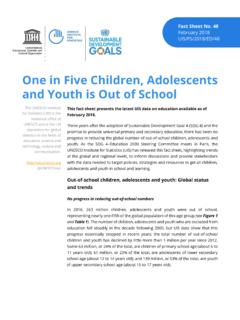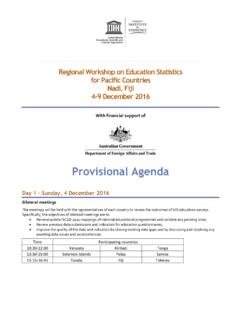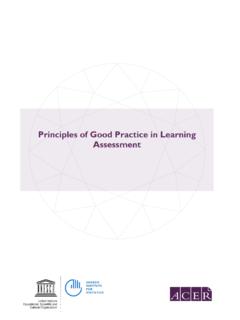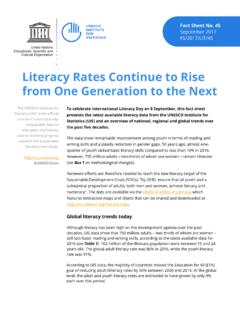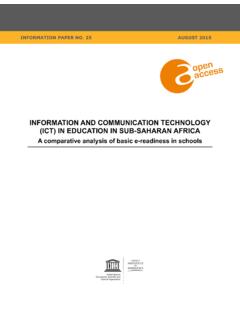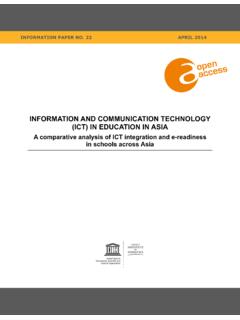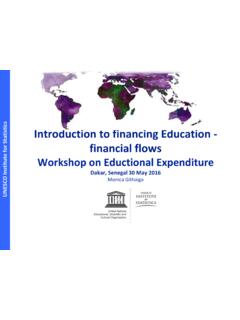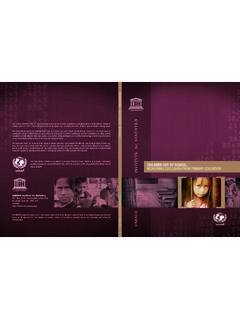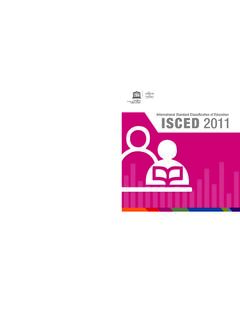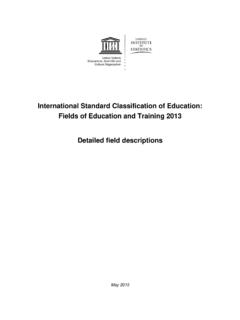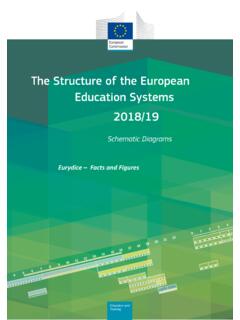Transcription of ISCED FIELDS OF EDUCATION AND - UNESCO
1 2695 The International Standard Classification of EDUCATION ( ISCED ) is a member of the United Nations International Family of Economic and Social Classifications and is the reference classification for organizing EDUCATION programmes and related qualifications by levels and FIELDS of EDUCATION . ISCED was first developed in the 1970s as the internationally-agreed framework for assembling, compiling and analysing cross-nationally comparable statistics on EDUCATION . The availability of a common international classification is only the first step towards the collection of comparable data. The second step is to ensure a consistent application of the classification across countries. The 2011 ISCED revision concentrates primarily on changes to the levels of EDUCATION of programmes ( ISCED -P) and introduces, for the first time, a classification of levels of educational attainment based on qualifications ( ISCED -A).
2 Adopted in 2013, ISCED -F describes and categorises the revised FIELDS of EDUCATION and training at the secondary, post-secondary and tertiary levels of EDUCATION as defined in ISCED 2011. The UNESCO Institute for Statistics (UIS) is the custodian of the ISCED family of classifications ( ISCED -P, ISCED -A and ISCED -F). The UIS is responsible for their development, maintenance, updating and revision. The Institute provides guidance on the effective and consistent use of ISCED for international data collection and UNESCO Institute for Statistics (UIS) is the statistical office of the United Nations Educational, Scientific and Cultural Organization ( UNESCO ) and is the UN depository for internationally comparable statistics in the FIELDS of EDUCATION , science and technology, culture and FIELDS OF EDUCATION AND TRAINING 2013 UNESCO INSTITUTE for STATISTICS Manual to accompany the International Standard Classification of EDUCATION 2011 ISCED FIELDS OF EDUCATION AND TRAINING 2013 ( ISCED -F 2013) UNESCO The constitution of the United Nations Educational, Scientific and Cultural Organization ( UNESCO ) was adopted by 20 countries at the London Conference in November 1945 and entered into effect on 4 November 1946.
3 The Organization currently has 195 Member States and 9 Associate Members. The main objective of UNESCO is to contribute to peace and security in the world by promoting collaboration among nations through EDUCATION , science, culture and communication in order to foster universal respect for justice, the rule of law, and the human rights and fundamental freedoms that are affirmed for the peoples of the world, without distinction of race, sex, language or religion, by the Charter of the United Nations. To fulfil its mandate, UNESCO performs five principal functions: 1) prospective studies on EDUCATION , science, culture and communication for tomorrow's world; 2) the advancement, transfer and sharing of knowledge through research, training and teaching activities; 3) standard-setting actions for the preparation and adoption of internal instruments and statutory recommendations; 4) expertise through technical co-operation to Member States for their development policies and projects; and 5) the exchange of specialized information.
4 UNESCO is headquartered in Paris, France. UNESCO Institute for Statistics The UNESCO Institute for Statistics (UIS) is the statistical office of UNESCO and is the UN depository for global statistics in the FIELDS of EDUCATION , science and technology, culture and communication. The UIS was established in 1999. It was created to improve UNESCO 's statistical programme and to develop and deliver the timely, accurate and policy-relevant statistics needed in today s increasingly complex and rapidly changing social, political and economic environments. The UIS is based in Montreal, Canada. Published in 2014 by: UNESCO Institute for Statistics Box 6128, Succursale Centre-Ville Montreal, Quebec H3C 3J7 Canada Tel: +1-514-343-6880 Email: UNESCO -UIS 2014 ISBN 978-92-9189-150-4 Ref: UIS/2014/INS/4 REV DOI This publication is available in Open Access under the Attribution-ShareAlike IGO (CC-BY-SA IGO) license ( ).
5 By using the content of this publication, the users accept to be bound by the terms of use of the UNESCO Open Access Repository ( ). The designations employed and the presentation of material throughout this publication do not imply the expression of any opinion whatsoever on the part of UNESCO concerning the legal status of any country, territory, city or area or of its authorities or concerning the delimitation of its frontiers or boundaries. - iii - Contents Page 1. Introduction .. 4 2. Aim of the manual .. 4 3. Units of classification .. 4 4. Scope and structure of the classification .. 5 5. Rationale of the classification .. 6 6. Application of classification criteria: Some examples .. 7 7. Inter-disciplinary and broad programmes .. 10 8. Coding other difficult cases .. 11 9. Aggregations for analysis and publication .. 12 10. Relation to ISCED 2011 and other classifications.
6 13 Appendix I. ISCED FIELDS of EDUCATION and training .. 18 - 4 - 1. Introduction 1. The International Standard Classification of EDUCATION ( ISCED ) is a framework for assembling, compiling and analysing cross-nationally comparable statistics on EDUCATION . ISCED is a member of the United Nations International Family of Economic and Social Classifications and is the reference classification for organizing EDUCATION programmes and related qualifications by levels and FIELDS of EDUCATION . First developed in the mid-1970s by the United Nations Educational, Scientific and Cultural Organization ( UNESCO ), ISCED has been revised twice most recently in 2011. ISCED is a product of international agreement and was adopted formally by the General Conference of UNESCO Member States. 2. The latest revision, ISCED 2011, concentrated primarily on changes to the levels of EDUCATION of programmes ( ISCED -P) and introduced, for the first time, a classification of levels of educational attainment based on qualifications ( ISCED -A).
7 3. During the review process which led to the 2011 revision, it was decided that the FIELDS of EDUCATION should be examined in a separate process to establish an independent but related classification which could be updated according to a different frequency, if appropriate, from any future revision to the levels of EDUCATION and educational attainment. The classifications of levels and FIELDS will remain part of the same family of classifications. Accordingly, this new classification will be referred to as the ISCED FIELDS of EDUCATION and Training ( ISCED -F). 2. Aim of this manual 4. The availability of a common international classification is only the first step towards the collection of comparable data. The second step is to ensure a consistent application of the classification across countries. Thus, the aim of this manual is to offer clear guidelines on how to apply the ISCED FIELDS of EDUCATION and Training.
8 This is done by both specifying a number of criteria to be observed and by providing lists of inclusions and exclusions from each field of EDUCATION and training. The detailed ISCED FIELDS of EDUCATION and Training classification is described in Appendix I. The classification will be accompanied by a comprehensive listing of the definitions of each field and examples of subjects that are included and excluded within each field in order to assist countries in defining the boundaries between each field. The comprehensive listing will include both an alphabetical and a numerical list for ease of reference. 3. Units of classification 5. The basic units of classification in ISCED 2011 are EDUCATION programmes and their related qualifications. These are the same units of classification in the ISCED FIELDS of EDUCATION and Training ( ISCED -F): a.
9 An EDUCATION programme is a coherent set or sequence of educational activities designed and organized to achieve pre-determined learning objectives or accomplish a specific set of educational tasks over a sustained period of time . Educational activities are deliberate activities involving some form of communication intended to bring about learning . - 5 - b. A qualification is the official confirmation, usually in the form of a document certifying the successful completion of an EDUCATION programme. Credits awarded for the successful completion of individual courses ( modules or subjects) are not considered as qualifications within ISCED . In such cases, a sufficient number of credits or subjects equivalent in duration and/or covering the curriculum of a full programme would represent a qualification.
10 6. ISCED FIELDS of EDUCATION and Training classifies EDUCATION programmes and related qualifications by FIELDS of study: a. A field is the broad domain, branch or area of content covered by an EDUCATION programme or qualification . 7. FIELDS of EDUCATION and training and levels of EDUCATION or educational attainment are cross-classification variables within ISCED and are therefore independent of each other. In particular, unlike the original ISCED 1976, FIELDS are not defined within levels of EDUCATION . This is because at some levels of EDUCATION , while programmes and qualifications are only available in some FIELDS of EDUCATION and training, this can vary between countries or over time. For example, teacher training or nursing are offered at different levels of EDUCATION in different countries. Over recent years there has been a tendency for such programmes to be phased out at lower levels of EDUCATION and the training to be up-graded to a higher ISCED level.
